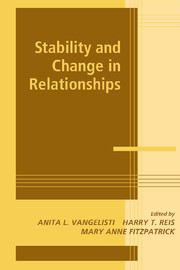Book contents
- Frontmatter
- Contents
- Contributors
- Preface
- PART ONE ACTORS: THE SCAFFOLDING OF STABILITY AND CHANGE
- 1 Change in Relationship Knowledge Representations
- 2 Personality Effects on Personal Relationships over the Life Span
- 3 An Intergenerational Model of Romantic Relationship Development
- 4 How Relationships Begin and End: A Genetic Perspective
- PART TWO BEHAVIORS: THE PROCESSES OF STABILITY AND CHANGE
- PART THREE CONTEXTS: SOCIAL ENVIRONMENTS FOR STABILITY AND CHANGE
- Author Index
- Subject Index
3 - An Intergenerational Model of Romantic Relationship Development
Published online by Cambridge University Press: 21 October 2009
- Frontmatter
- Contents
- Contributors
- Preface
- PART ONE ACTORS: THE SCAFFOLDING OF STABILITY AND CHANGE
- 1 Change in Relationship Knowledge Representations
- 2 Personality Effects on Personal Relationships over the Life Span
- 3 An Intergenerational Model of Romantic Relationship Development
- 4 How Relationships Begin and End: A Genetic Perspective
- PART TWO BEHAVIORS: THE PROCESSES OF STABILITY AND CHANGE
- PART THREE CONTEXTS: SOCIAL ENVIRONMENTS FOR STABILITY AND CHANGE
- Author Index
- Subject Index
Summary
“In conducting research on the quality of life of the American population, time and again we came to the conclusion that for most adults the cornerstone of a solidly constructed satisfying life free from overwhelming tensions is a happy and stable marriage” (Veroff, Douvan, & Hatchett, 1995, p. xiii). This quote underscores growing evidence that close social relationships promote personal well-being. Conversely, failure to establish or maintain such relationships in general, and romantic relationships in particular, predicts both physical and emotional distress (House, Landis, & Umberson, 1988; Simon & Marcussen, 1999; Wickrama, Lorenz, Conger, & Elder, 1997). Spouses and their children may experience negative emotional, physical, behavioral, social, or economic consequences as a result of either marital dissolution or ongoing marital conflict (Gottman, 1994; Halford, Kelly, & Markman, 1997; Harold & Conger, 1997; House et al., 1988; Simon & Marcussen, 1999).
Changes seen over the past few decades such as increases in divorce and remarriage, as well as the delaying of marriage, suggest that a large number of people experience the problems created by distress in relationships, while others lack the health-promoting benefits of satisfying romantic ties. Findings indicate that people who are able to establish and maintain a stable and happy romantic union experience a significant health advantage, compared to those who cannot. Despite the acknowledged importance of competence in intimate relationships, little is known about the developmental roots of the ability to successfully initiate and sustain such relationships (Christensen, 1998; Parke, 1998).
Information
- Type
- Chapter
- Information
- Stability and Change in Relationships , pp. 57 - 82Publisher: Cambridge University PressPrint publication year: 2002
Accessibility standard: Unknown
Why this information is here
This section outlines the accessibility features of this content - including support for screen readers, full keyboard navigation and high-contrast display options. This may not be relevant for you.Accessibility Information
- 67
- Cited by
